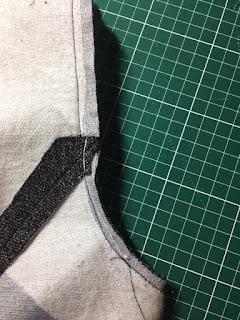Most of the corners of seams are therefor cut at an angle.

The seam of the facing is graded. The facing is cut shorter than the front pattern piece. In general the seam allowance that is closest to the outside of the garment is longer.
For the corner at the hem I cut back as in the following picture.

The armhole seam is trimmed to 1 cm at the upper part, only half a centimeter at the lower part. Mostly this is 2/3 and 1/3 of the height. In this case I cut the side panels to a smaller seam allowance.
For the sleeves I use a sleevehead and shoulderpads. The smallest shoulderpads that I can find (in height), as they are not used for getting height or width (the 80's are a long time ago), but just to give the shoulder area and the top of the sleeve a bit more support.
Sleeveheads are never mentioned in Burda instructions, nor were the shoulderpads part of the construction for this jacket. I just prefer to use them anyway.
Sleeveheads are never mentioned in Burda instructions, nor were the shoulderpads part of the construction for this jacket. I just prefer to use them anyway.

The sleeve head is attached on the inside of the sleeve. I use basting thread, very close to the seam. On a tailoring course I once took I learned that basting thread was often used on the inside, because it's not slippery.
I'm close to finishing. Hemming still to be done and of course the lining. Hopefully sometime this week.


















